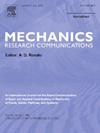Experimental and analytical investigation on the shear performance of double-lap adhesive joints with multi-layered adherends
IF 2.3
4区 工程技术
Q3 MECHANICS
引用次数: 0
Abstract
In the present study, shear tests were carried out on double-lap adhesive joints between glass and PVC adherends to investigate their mechanical behaviour and to verify the effectiveness of steel reinforcement – with different thicknesses – for the inner PVC adherend. In particular, two different commercially available structural epoxy adhesives as well as glass and PVC adherends were used in the bonded joints. The first part of the study illustrates the analytical model used to calculate the stress distribution in the adhesives and bonded joints. The second part analyses the mechanical properties of the materials used, which were tested experimentally. The third part illustrates the results obtained on double-lap joints in classical and reinforced configurations. The results show that it is possible to improve the mechanical behaviour of the joint in terms of strength and stiffness. It is shown both experimentally and analytically that the use of thicker steel reinforcements does not lead to further significant improvements. The best mechanical performance is achieved in each configuration by the first epoxy adhesive. As far as the failure modes are concerned, while in the unreinforced configurations one observes the failure of the loaded adherend (“Stock-Break” Failure), in the reinforced joints only “Glass Failure” mode are observed, which is due to the different transfer of stresses.
多层粘接双搭接接头抗剪性能的试验与分析研究
在本研究中,对玻璃和PVC胶粘剂之间的双搭接接头进行了剪切试验,以研究其力学行为,并验证不同厚度的钢筋对内部PVC胶粘剂的有效性。特别地,两种不同的市售结构环氧胶粘剂以及玻璃和PVC胶粘剂被用于粘合接头。研究的第一部分阐述了用于计算胶粘剂和粘结接头应力分布的解析模型。第二部分分析了所用材料的力学性能,并进行了实验测试。第三部分给出了经典和加强型双搭接的结果。结果表明,在强度和刚度方面改善接头的力学性能是可能的。实验和分析都表明,使用较厚的钢筋不会导致进一步的显著改善。在每种配置中,第一种环氧胶粘剂都能达到最佳的机械性能。就破坏模式而言,在未加筋配置中,人们观察到加载附着物的破坏(“Stock-Break”破坏),而在加筋节点中,只观察到“玻璃破坏”模式,这是由于应力传递的不同。
本文章由计算机程序翻译,如有差异,请以英文原文为准。
求助全文
约1分钟内获得全文
求助全文
来源期刊
CiteScore
4.10
自引率
4.20%
发文量
114
审稿时长
9 months
期刊介绍:
Mechanics Research Communications publishes, as rapidly as possible, peer-reviewed manuscripts of high standards but restricted length. It aims to provide:
• a fast means of communication
• an exchange of ideas among workers in mechanics
• an effective method of bringing new results quickly to the public
• an informal vehicle for the discussion
• of ideas that may still be in the formative stages
The field of Mechanics will be understood to encompass the behavior of continua, fluids, solids, particles and their mixtures. Submissions must contain a strong, novel contribution to the field of mechanics, and ideally should be focused on current issues in the field involving theoretical, experimental and/or applied research, preferably within the broad expertise encompassed by the Board of Associate Editors. Deviations from these areas should be discussed in advance with the Editor-in-Chief.

 求助内容:
求助内容: 应助结果提醒方式:
应助结果提醒方式:


